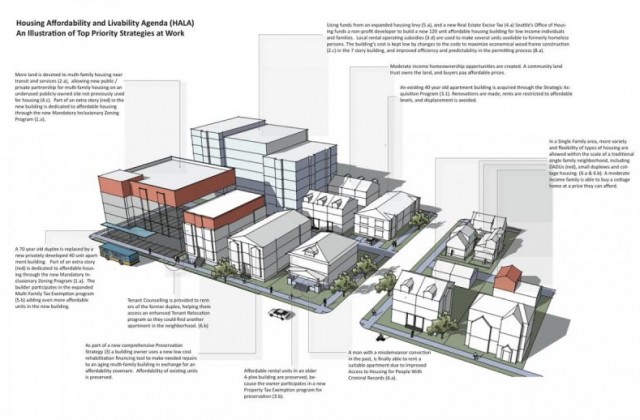Seattle Times Right and Wrong on Grand Bargain
The Seattle Times weighed in yesterday on the passage earlier in the week of key legislation that starts the City down the road of mandatory inclusionary zoning through the much hyped Grand Bargain. We’ve pointed out that, so far, the math isn’t working: the mandatory upzones proposed for neighborhood builders will cost more than the rent revenue created by the new square footage. This will make many projects infeasible. Infusibility spells failure for the Mayor’s goal of creating 6000 rent restricted units from the scheme and it also means possible law suits. The Times editorial, however, gets some things right and some things wrong.
This not a time for kudos. The council was too hasty and Monday’s action undermines the public input process scheduled for 2016.
I agree on the part about this not being a “time for kudos.” The Times rightly points out that the Council is the lamest of lame ducks at this point, with almost half of the current members not returning, and the remaining members mostly supporting smaller districts rather than the whole city.
I don’t think the Bargain needs a lot more public input. The proposal already doesn’t work in the neighborhoods. The Times, though, worries about whether neighbors will have a chance to question upzones.
How much say will the public have now that the council has approved the essence of the plan, inked the “bargain” and started the ball rolling?
Hearings will at least let residents question upzones. They might also ask why the city insists on ever-taller buildings and doubling or tripling density in single-family zones with “accessory dwelling units,” even though planners say current zoning has plenty of capacity.
Letting neighbors run their fingers through this deal won’t make it any more feasible. In fact, what the Times is suggesting almost assures that the Bargain will unravel.
Residents might also use hearings to protest loopholes in Monday’s ordinance.
Loopholes? Really. Like what? Neighborhood builders are already on the hook to build 6000 units in their projects, and right now it looks like they’d have to build those at a loss. That’s not fair. But I don’t see what “loopholes” are being exploited. What’s likely once crowds of neighbors get involved is that the Bargain will become even less of a bargain not because of loopholes but because of more requirements, rules, regulations, and fees.
And the Times makes a key mistake of fact.
Yet Monday’s vote codified HALA’s linchpin — linkage fees that will be collected from developers of commercial buildings and used to subsidize affordable housing projects. That’s the heart of the “grand bargain” Murray cut with developers in crafting HALA.
The linchpin of the Bargain is not the commercial upzones with fees, but the currently infeasible neighborhood upzones to build the 6000 units set by the Mayor’s office. Everyone has know for a long time that the majority of projects paying into the City’s Incentive Zoning program–essentially allowing developers to buy extra square footage–have been commercial developments. The economics work better there for in lieu payment toward housing subsidies. It’s the Mandatory Inclusionary Zoning that is the linchpin and one of the biggest weaknesses of the Bargain.
The Times seems confused about the Downtown and South Lake Union components of the deal.
Some passages are so generous to developers, they’re destined to be the punchline of jokes their lawyers will tell over $60 steaks at the Metropolitan Grill.
One loophole perversely cuts linkage fees if developers show that poor people won’t get jobs in their new buildings. By the city’s logic, better-paid workers don’t need “affordable” housing and won’t have the same impact on the housing market as lower-paid workers.


